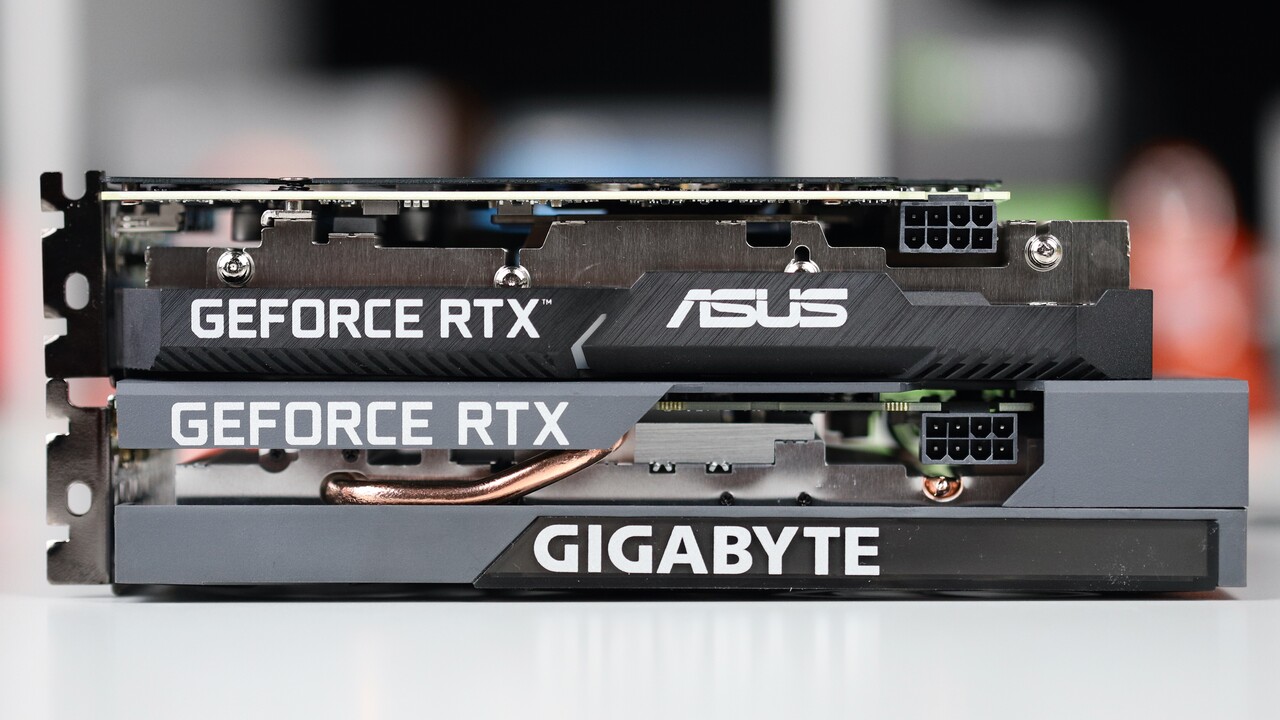Nvidia GeForce RTX 3050 “titleonly”
: Test |CUP | Specs |Config
The GeForce RTX 3050 8GB is Nvidia’s new entry-level gaming graphics card with amps. In the test, the graphics card for an official RRP of 279 euros proves to be a good all-rounder with all the well-known ampere properties without any real weaknesses. Even the red pen on the PCIe interface is hardly noticeable in the benchmark in this case.
Updated 02/11/2022 1:41 p.m
Update 01/27/2022 2:30 p.m
After a rather unspectacular year 2021 in terms of graphics cards, the year 2022 promises to be really exciting again technically. But before AMD RDNA 3, Nvidia Lovelace and Intel Arc start for the first time, it is the turn of the new RTX 3000 for notebooks (test) and new entry-level graphics cards for gaming PCs. AMD’s Radeon RX 6500 XT made the start, the test of which is still pending on ComputerBase: AMD had withheld samples and drivers from the editors. In the meantime, both are available, worried about other ways. But today it’s all about Nvidia’s new smallest RTX 3000, which was available in advance under the NDA.
GeForce RTX 3050: entry without cut for 279 euros RRP
The embargo on tests of the new GeForce RTX 3050 falls today – from the afternoon of January 27th, retailers are allowed to sell. The RRP quoted by Nvidia is 279 euros. However, there will only be custom designs. It remains to be seen what partners and dealers will do with the official entry-level RRP.
If the disappointing Radeon RX 6500 XT costs at least 300 euros, the 3050 should quickly cost well over 400 euros – the RTX 3060 is currently not available for less than 700 euros. Regardless of the price level, the RTX 3050 is also worth a premium over the RX 6500 XT.
In contrast to the 6500 XT, the GeForce RTX 3050 has a full video unit, can control at least four monitors and has access to 8 GB of memory. In terms of capabilities and features, the Ampere entry (almost) corresponds to the other models.
Incidentally, the RX 6500 XT is not yet included in this test. Running it on a PCI Express 4.0 system without a hitch for the sake of this article would not do justice to the idea of this graphics card. For the sake of completeness and because it would also have had its own independent article under the NDA, a separate article follows. It is not a serious technical alternative to the RTX 3050 either way.
So this article is only about the GeForce RTX 3050 and primarily about the question of how fast the new entry-level class with Ampere GPU is.
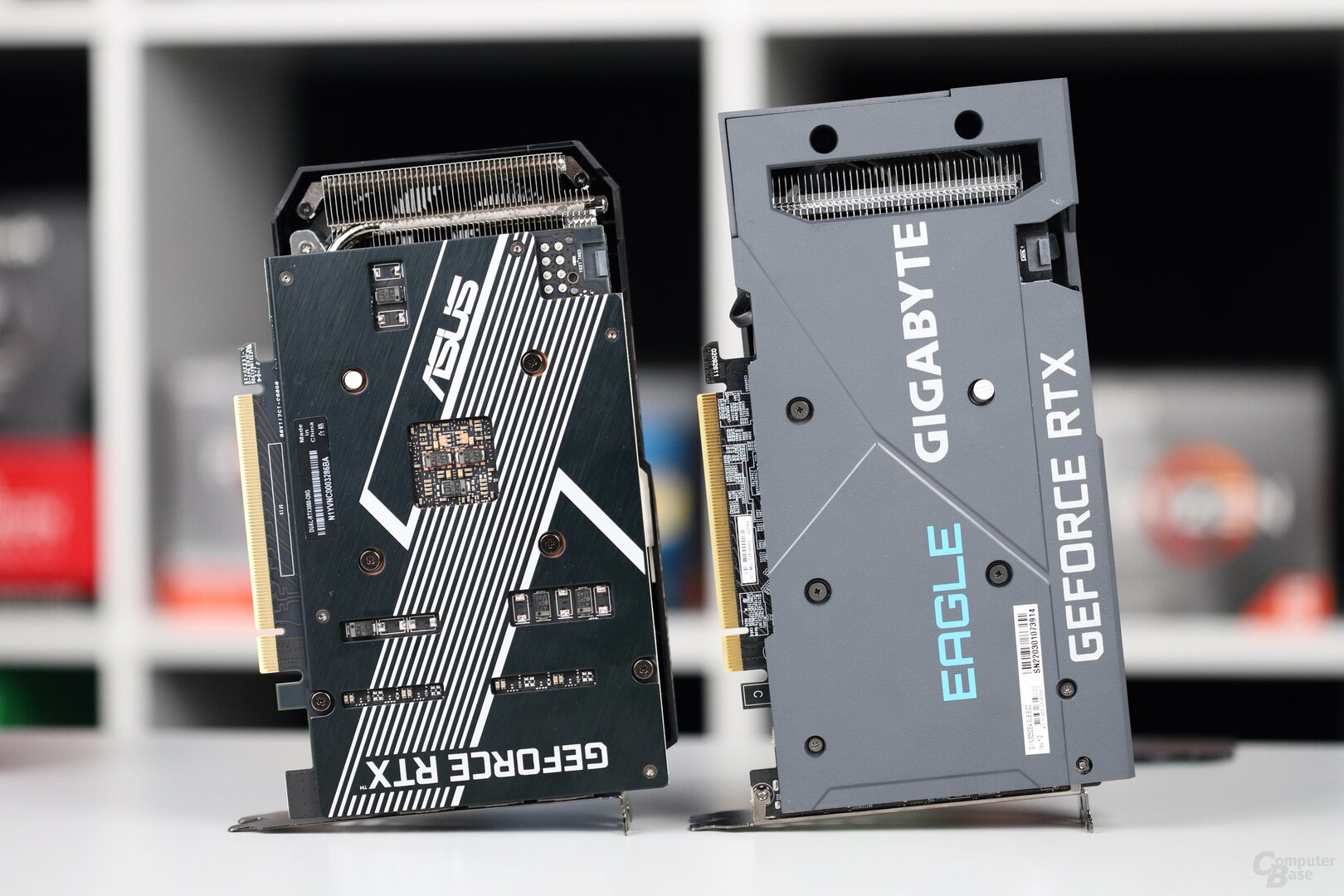
GeForce RTX 3050 from Asus (left) and Gigabyte (right) in the test
Bild 1 von 4

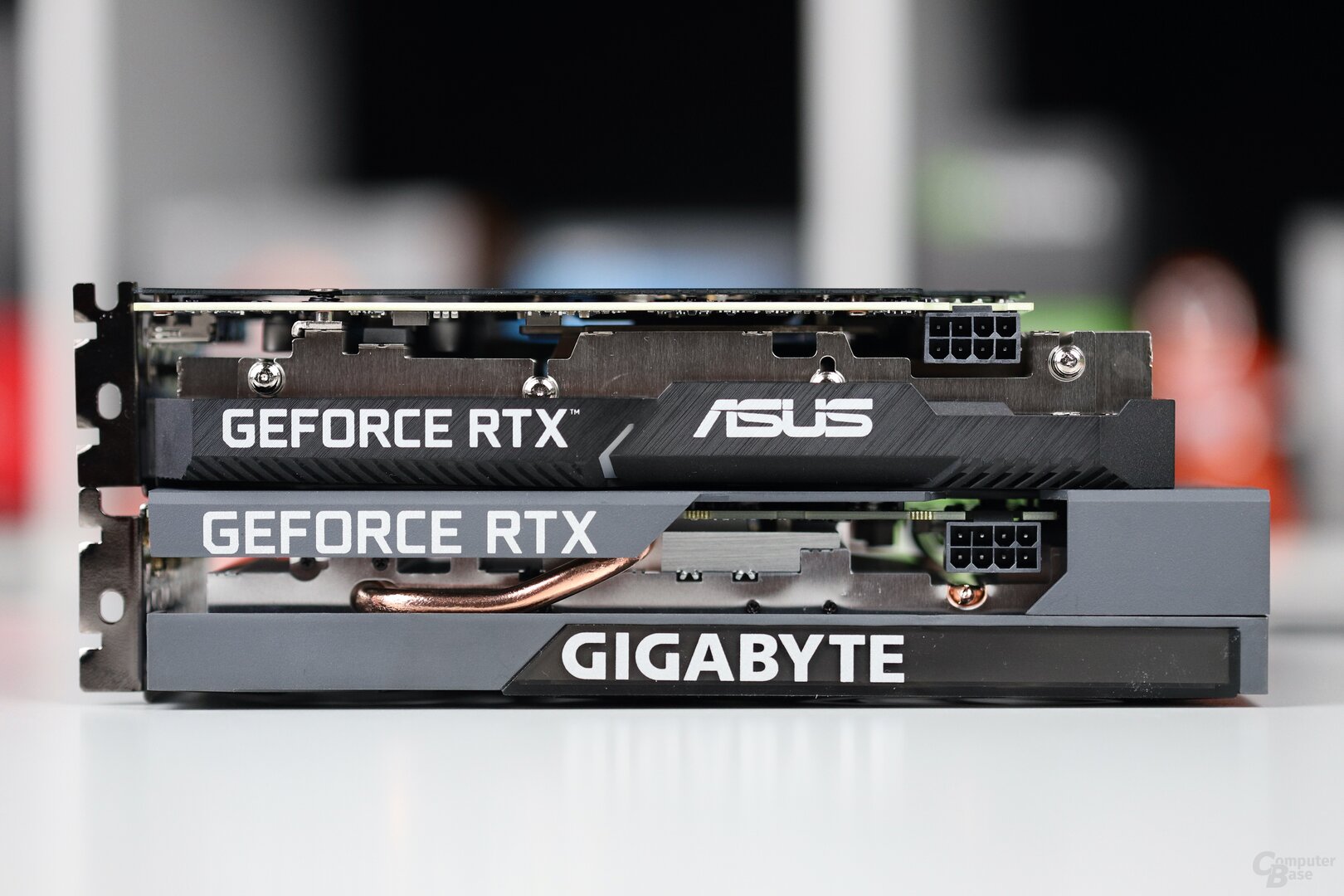
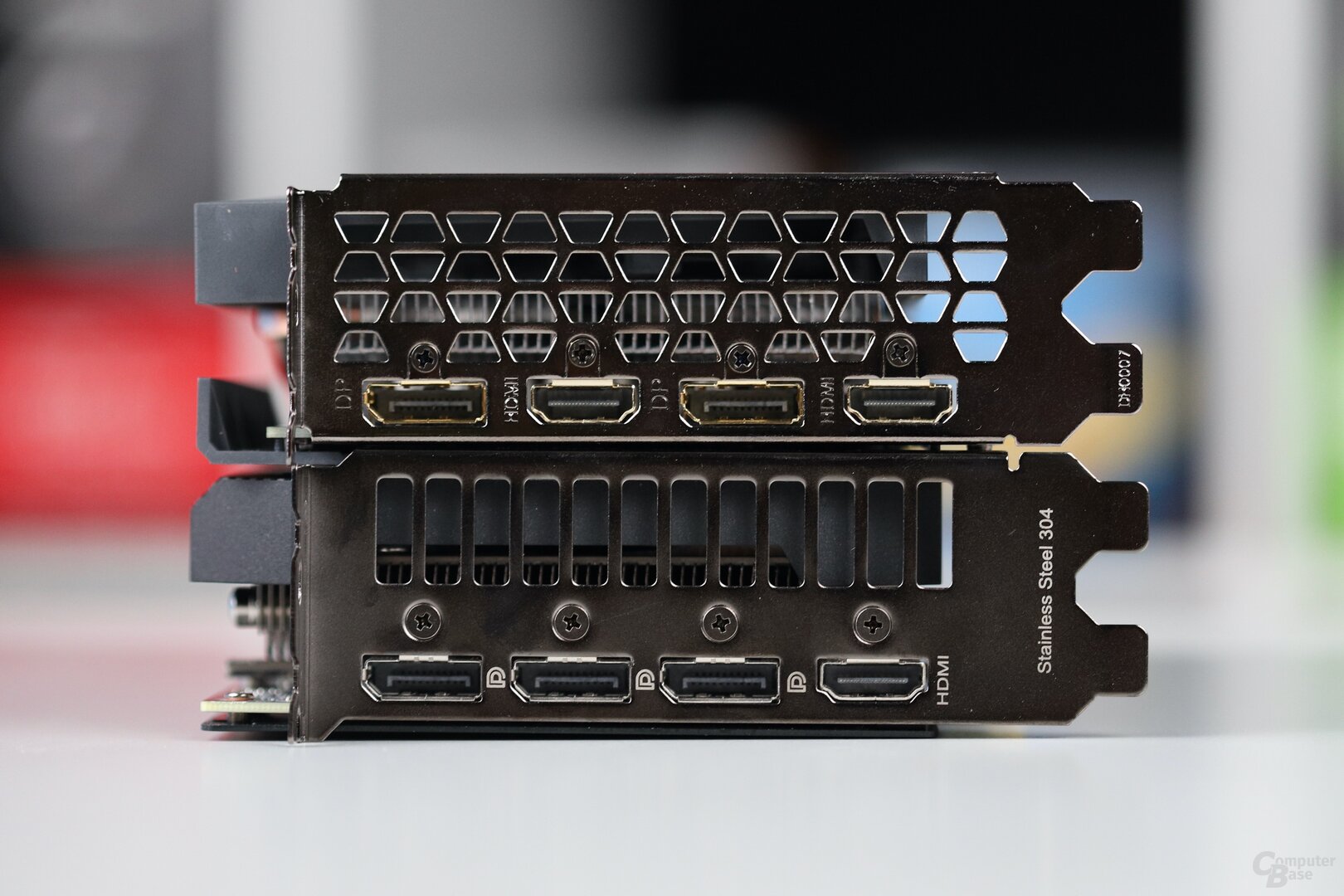
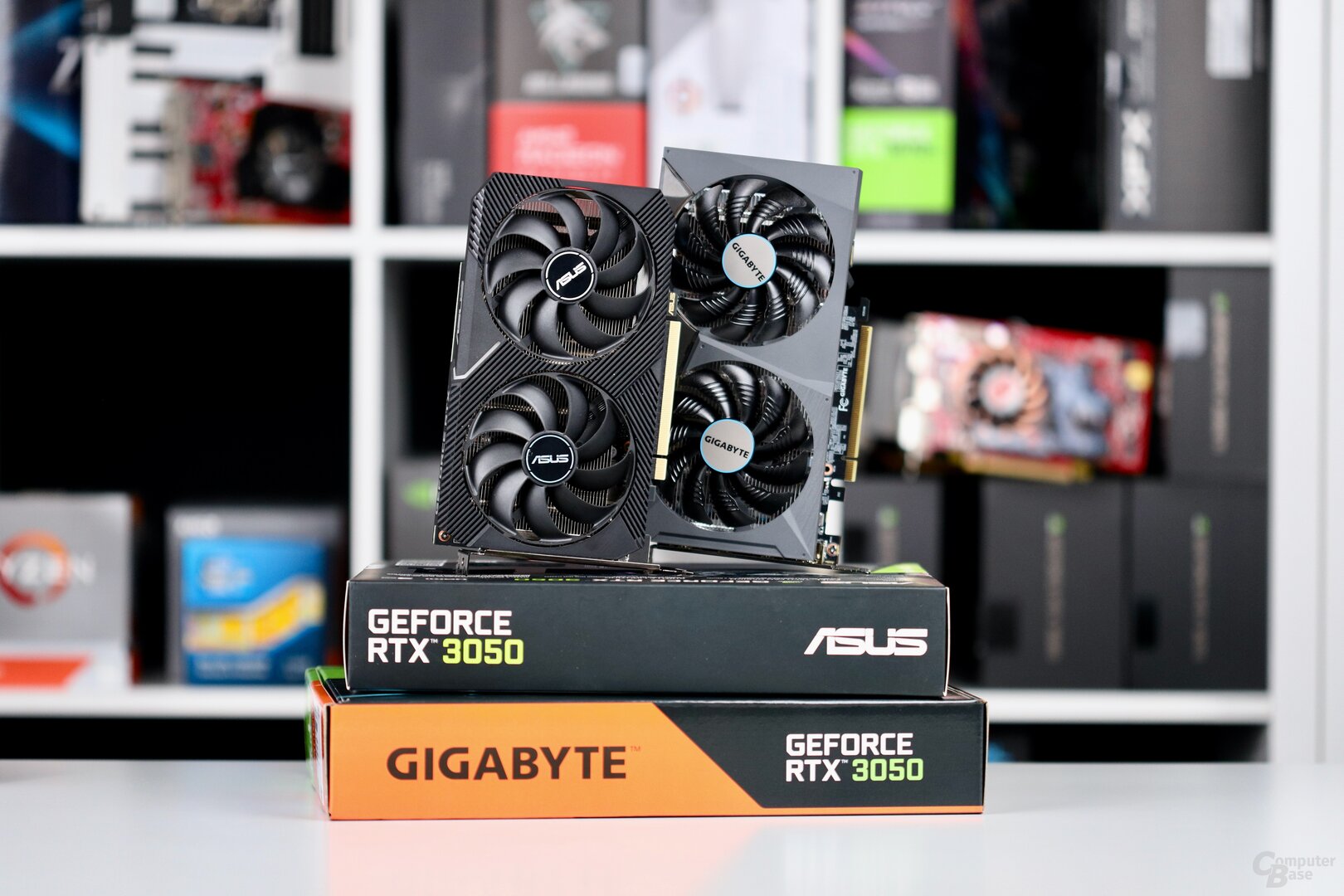
Custom design from Asus and Gigabyte tested
To find out, the Asus GeForce RFTX 3050 Dual OC and the Gigabyte GeForce RTX 3050 Eagle came to the test. The simple custom designs have to prove themselves against models such as the GeForce GTX 1060, GeForce GTX 1660 Super, Radeon RX 580 and Radeon RX 5500 XT in a beginner’s test course set up especially for the low-end accelerators.
No small GPU, but the GA106 is in the RTX 3050
For the Radeon RX 6500 XT, AMD has used the super small Navi 24 GPU, which is manufactured by TSMC in the new N6 manufacturing process and is just 107 mm² in size. Nvidia, on the other hand, takes a completely different approach with the GeForce RTX 3050 and uses the GA106 already known from the GeForce RTX 3060. This automatically comes from Samsung’s 8 nm production and measures a huge 276 mm² in comparison. However, the unchanged 12 billion transistors have the advantage that the graphics card, unlike the competitor model, comes with – almost – all known features.
Accordingly, there are full video capabilities: The GPU can decode and encode H.264 and H.265. In addition, the modern AV1 codec is supported. The GPU can also control more than two monitors. Nvidia provides four displays with HDMI 2.1 or DisplayPort 1.4 for the GeForce RTX 3050, but in the end it is the partner who decides. Another big difference to the AMD graphics card is the 8 instead of 4 GB memory. Nvidia offers more memory than AMD – yes, there is that too.
The PCIe interface is artificially reduced to 8 PCIe lanes
Even if the GA106 offers the full 16 PCIe 4.0 lanes and the GeForce RTX 3060 also uses them, Nvidia slows down the bus bandwidth on the GeForce RTX 3050. Nvidia does not go into this in the Reviewer’s Guide, but practice provides evidence: There are only 8 lanes after PCIe 4.0. That’s still twice as many lanes as AMD’s Radeon RX 6500 XT, but still a reduction compared to the larger and older graphics cards. The test will clarify the effects of this. In any case, the RTX 3050 will benefit from the fact that it rarely has to obtain data via the PCIe bus as a result of the 8 GB of memory.
At the beginning with GA106, later with GA107
But why is Nvidia taking the step at all when the GPU already has everything for PCIe x16? Because the GeForce RTX 3050 is only equipped with the GA106 at the beginning. Later it will be replaced by the smaller GA107 with otherwise the same specifications. And it only offers 8 PCIe 4.0 lanes.
RTX 3050 vs RTX 3060: The differences
At 8 GB, the GeForce RTX 3050 has 4 GB less VRAM than the GeForce RTX 3060, but Nvidia has added additional brakes to differentiate the two models, despite the identical GA106 GPU at launch. Instead of using all three graphics processing clusters of the GA106, only two of them are active on the GeForce RTX 3050, for example. This reduces all existing execution units by a third, resulting in 2,560 instead of 3,584 FP32 ALUs. With the same clock, the computing power is reduced by a third.
When it comes to clock rates, Nvidia lists a base clock of 1,552 MHz and an average boost of 1,777 MHz. The boost is therefore the same as with the GeForce RTX 3060, but official clock rates for amperes only have little significance. A maximum of 130 watts are required for this, 40 watts less than the larger GeForce model. Theoretically, cards with a 6-pin power connector are possible, but 8-pin versions are more likely to be used.
The memory was also reduced on the GeForce RTX 3050. The memory interface is only 128 instead of 192 bits wide, which automatically reduces the L2 cache from 2.3 to 1.5 MB. The memory clock is specified as 7,000 MHz, so the memory bandwidth (224 GB/s) has been reduced more than the computing power in the low-end hardware.
Die Asus GeForce RTX 3050 Dual OC im Detail
With the GeForce RTX 3050 Dual OC, Asus is launching a fairly compact but high-quality custom design, whose RRP should be over 279 euros – but Asus has not yet commented on this. The dual-slot design is not exceeded and the length is limited at 20 cm. Considering that it is a low-end product and only plastic is used for the cooler, the graphics card makes a surprisingly high-quality impression.
The cooling system is still a simple construction: there is an aluminum cooling plate directly above the GA106 GPU including several fins that even protrude over the PCB (17 cm). Four heat pipes ensure faster heat transport from the base plate to the radiator. Two axial fans with a diameter of 90 mm are responsible for the fresh air, which stops at low temperatures.
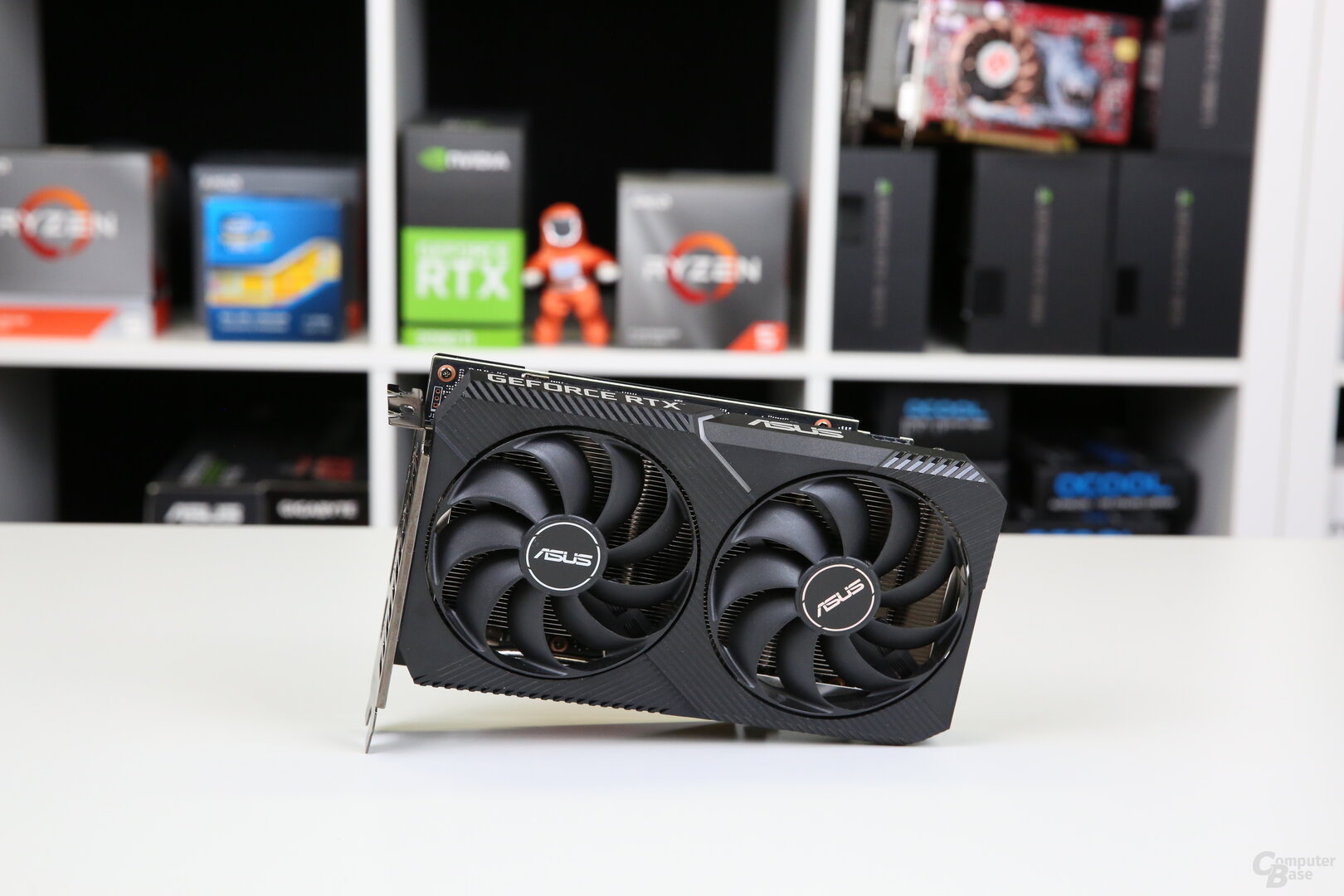
Die Asus GeForce RTX 3050 Dual OC “titleonly”
Bild 1 von 4

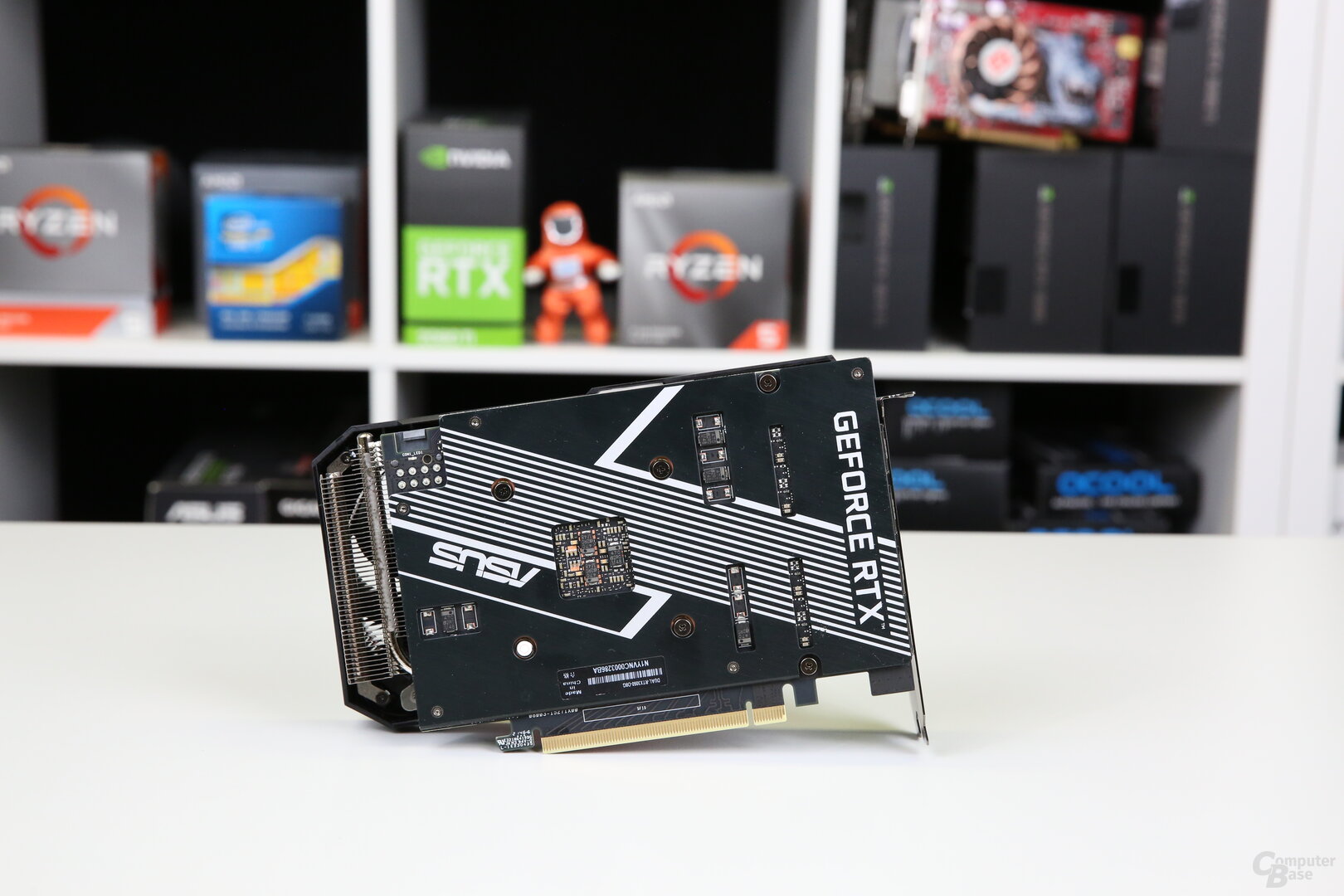
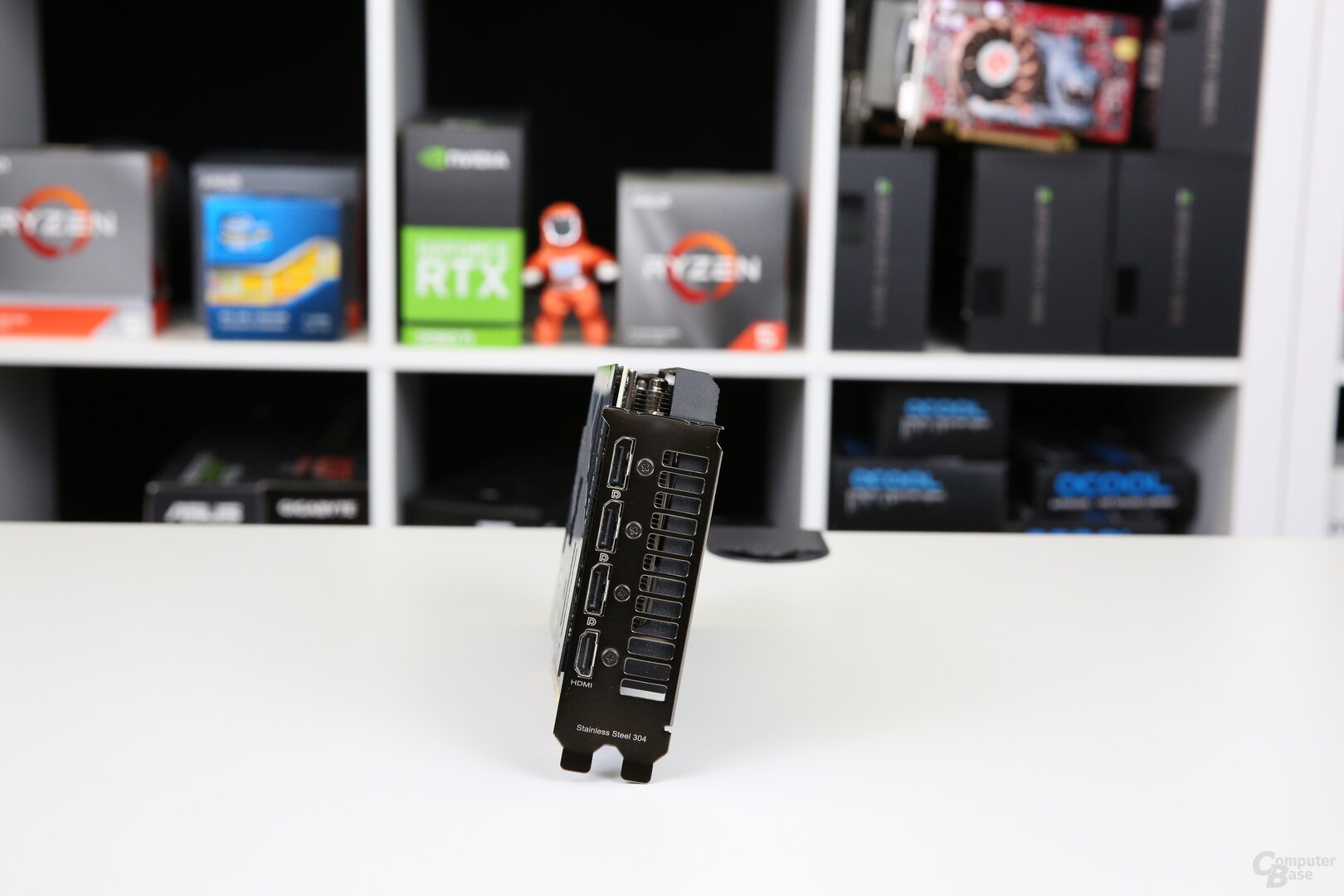
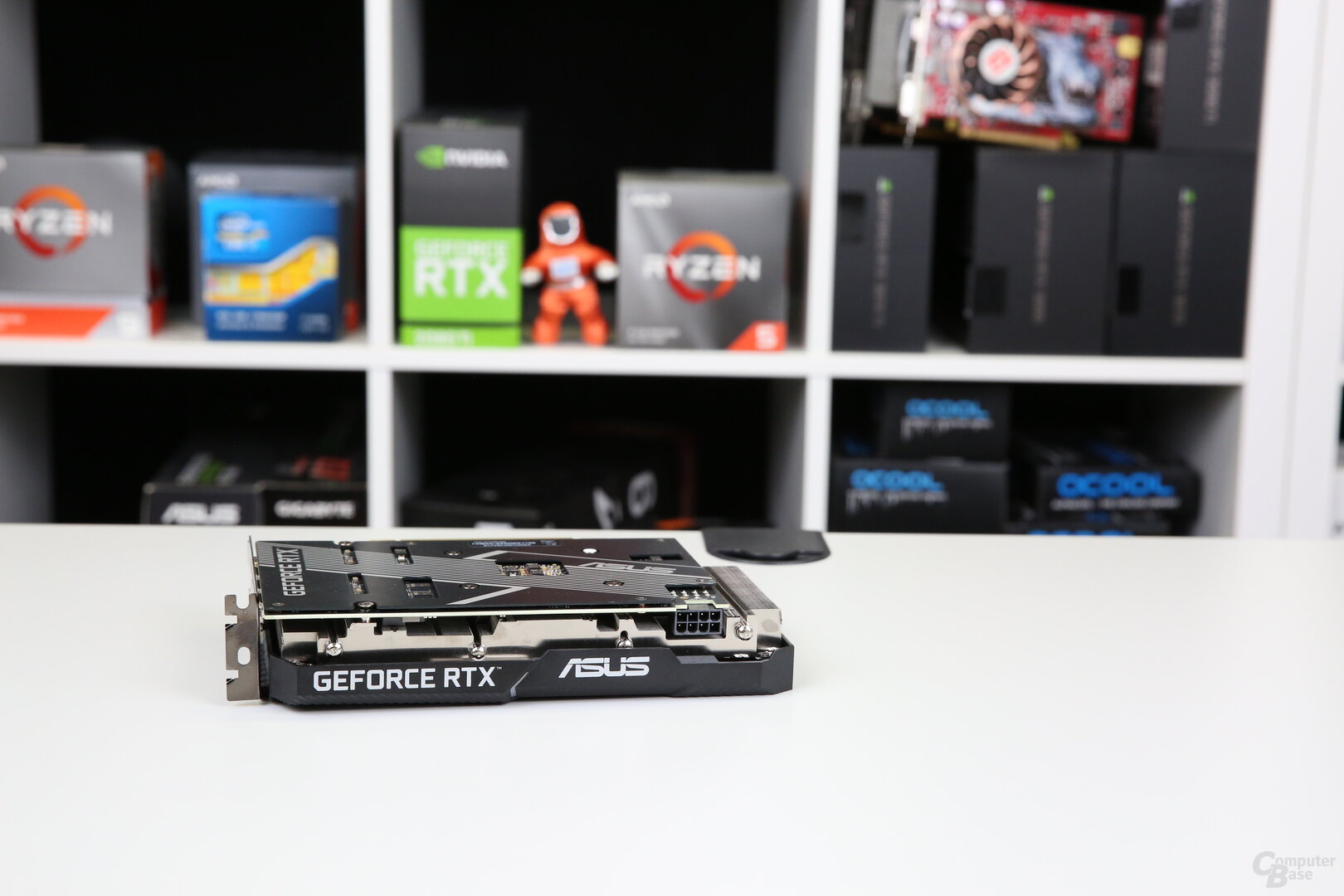
Asus has slightly overclocked the GeForce RTX 3050 Dual OC. The average boost is specified as 1,822 MHz, which is 45 MHz more than Nvidia allows. If that’s not enough, you can use the Asus tool to increase the frequency to 1852 MHz using the OC mode. The 8 GB GDDR6 memory runs at the usual 7,000 MHz and the power consumption remains at the normal 130 watts. An 8-pin power connector is required for operation.
Apart from that, nothing more can be said about the GeForce RTX 3050 Dual OC. There is no RGB, no second BIOS and no other gimmicks that would be unusual for a budget graphics card anyway. Monitors can be connected to three DisplayPorts 1.4 with DSC or to an HDMI 2.1 output.
Die Gigabyte GeForce RTX 3050 Eagle im Detail
The Gigabyte GeForce RTX 3050 Eagle is a model that will be launched at a price of 279 euros and thus Nvidia’s official entry-level price recommendation – it remains to be seen what the trade will make of it.
Although Asus and Gigabyte use a lot of plastic, Gigabyte also looks a lot more like it – and even the backplate uses it and not metal, which would dissipate heat better. The corners of the cooler are unusually sharp, so care should be taken when handling the graphics card.
Gigabyte relies on the same concept as the competitor for the cooler: There is a base plate including numerous fins and in this case a single, albeit long, curved heat pipe. Two fans with a diameter of 85 mm are responsible for ventilation; they stop at low temperatures, such as on the Windows desktop.
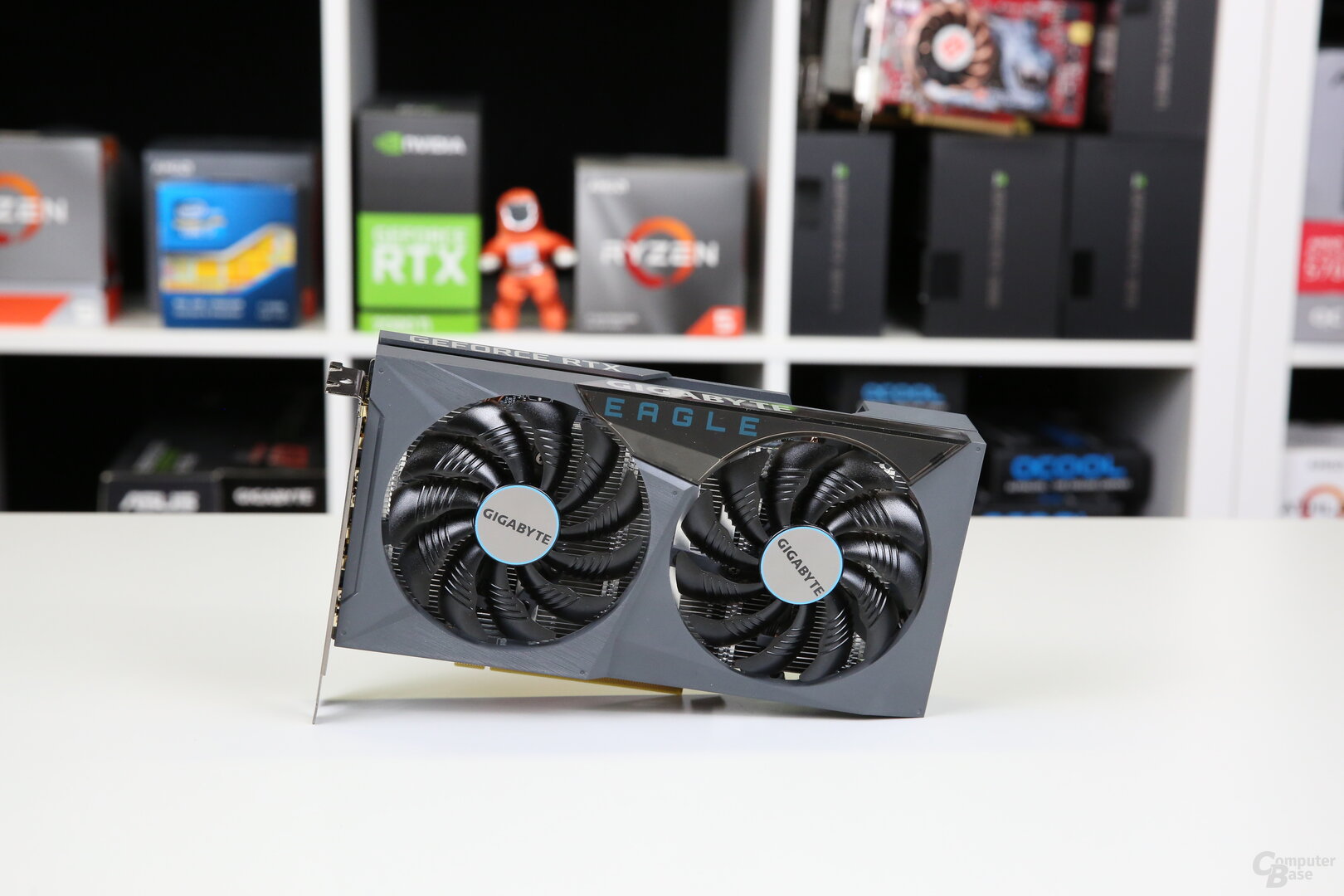
Die Gigabyte GeForce RTX 3050 Eagle “titleonly”
Bild 1 von 4

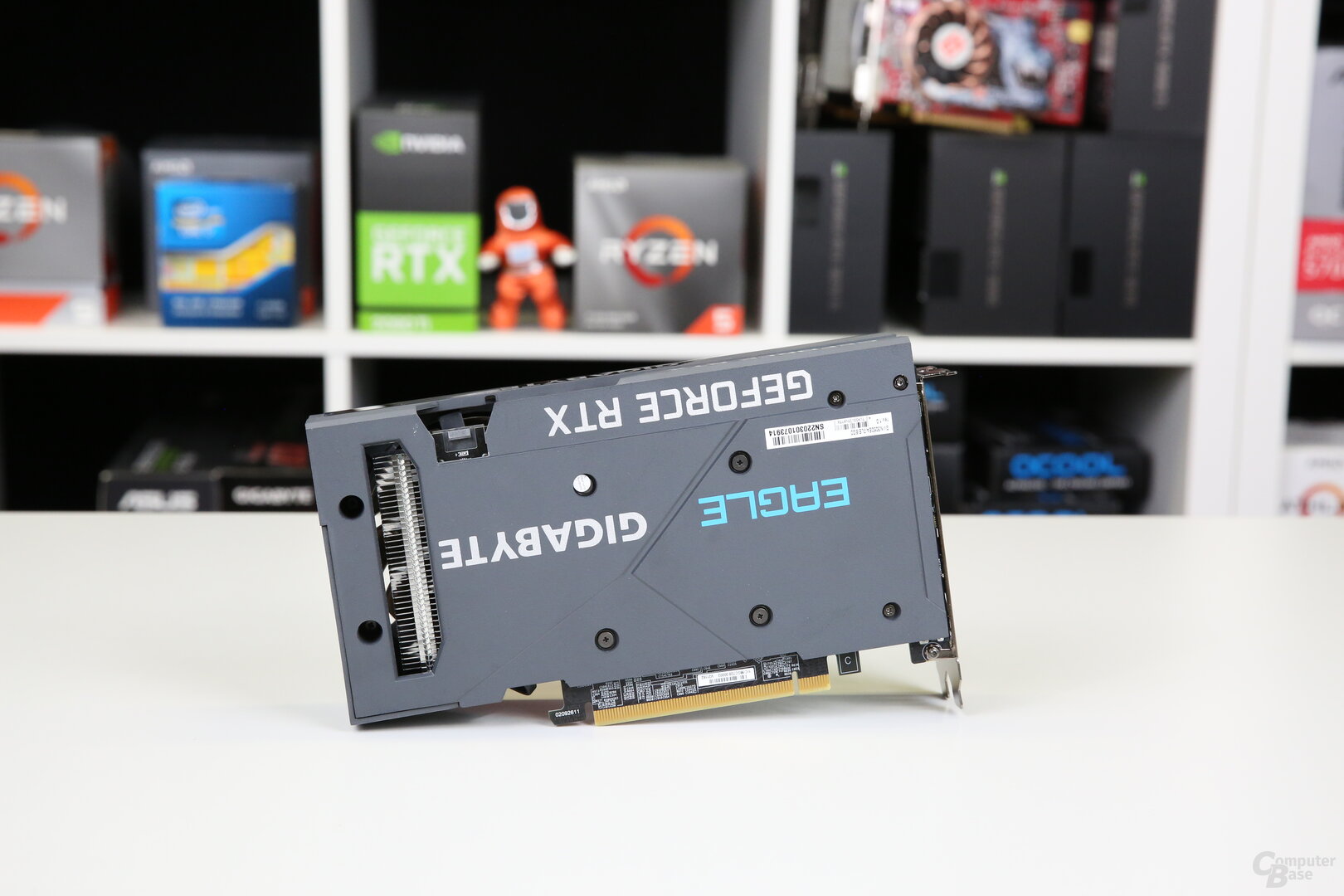
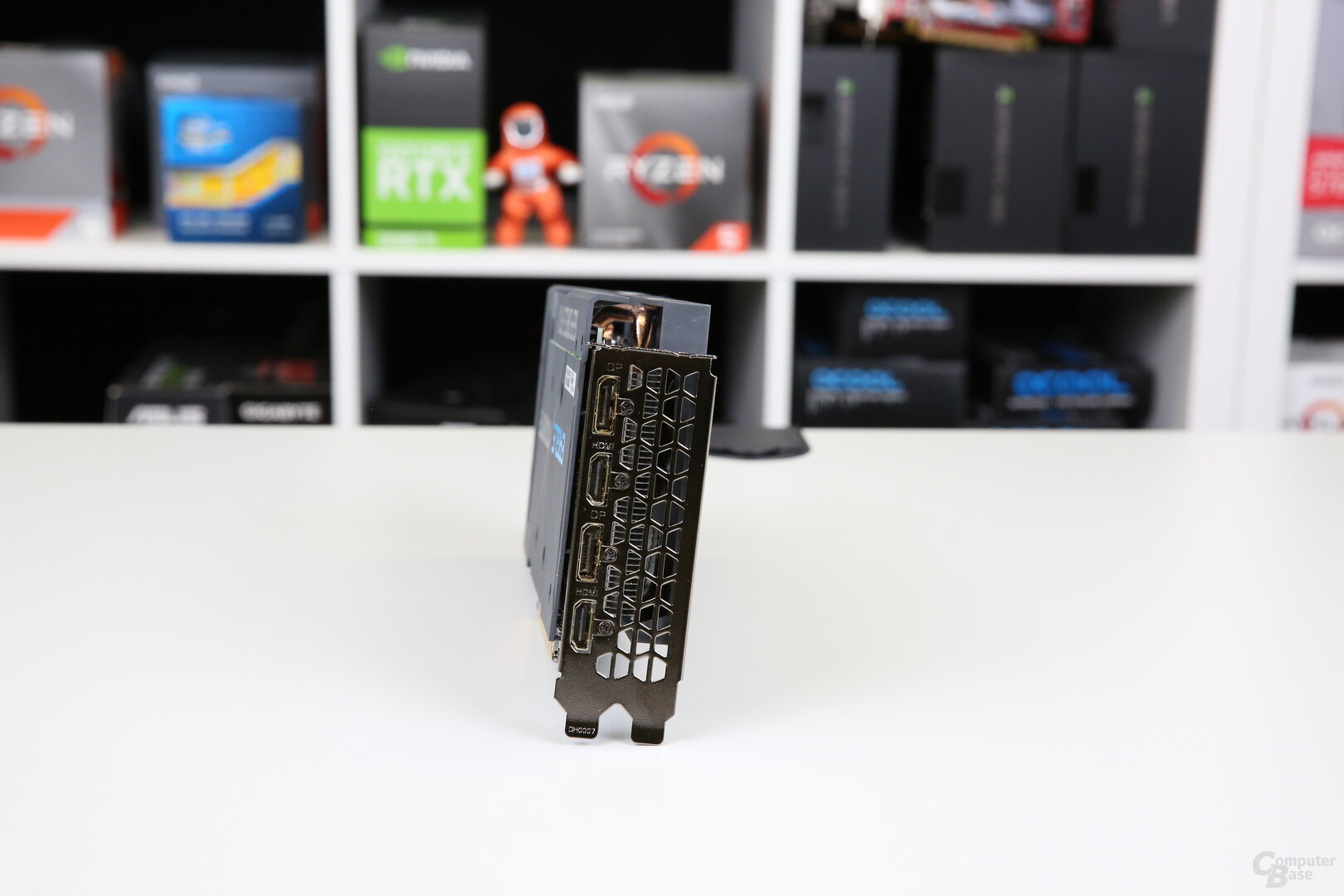
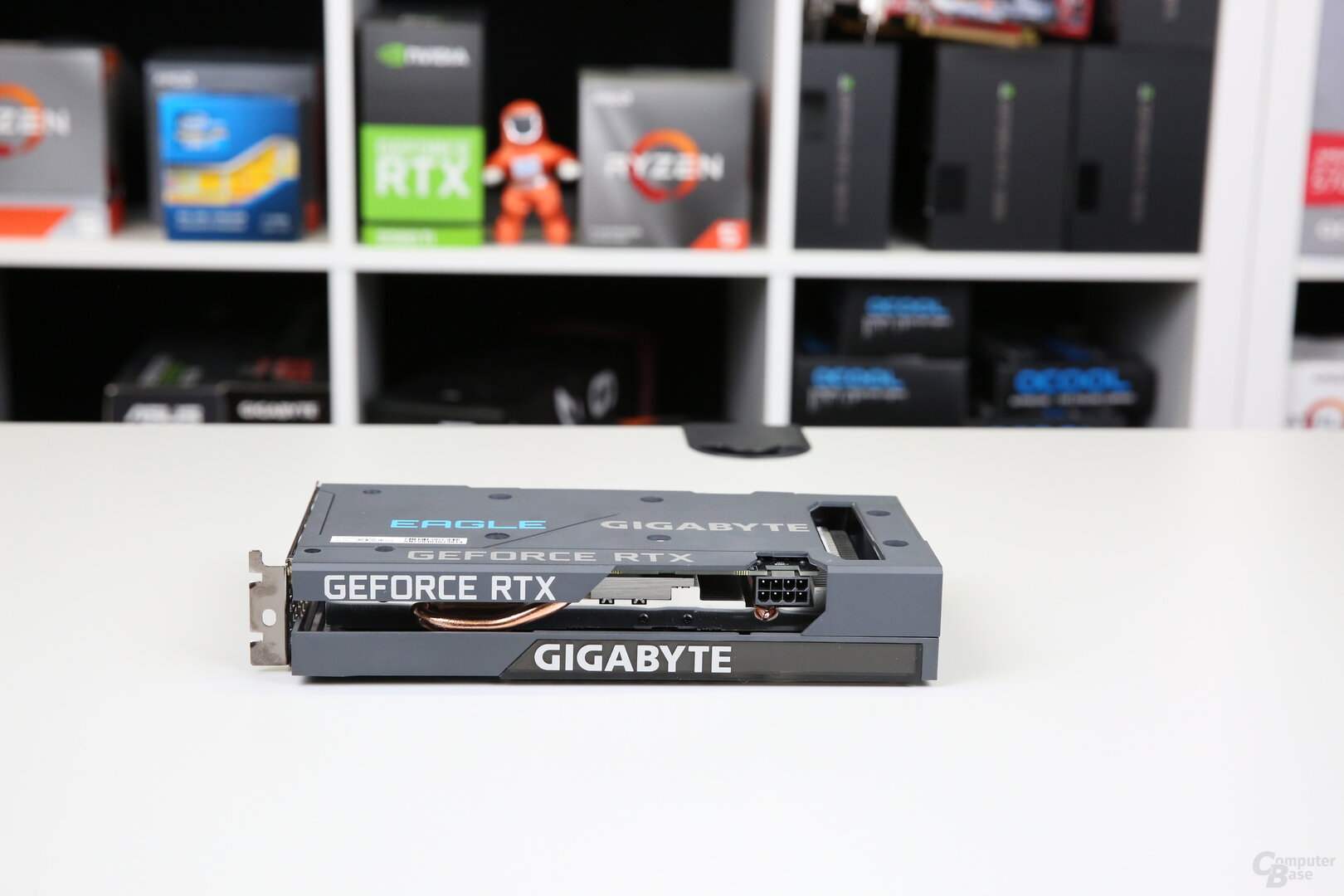
When it comes to clock rates, Gigabyte leaves it at Nvidia’s reference specifications on the GeForce RTX 3050 Eagle. Accordingly, the base clock is 1,552 MHz and the average boost is 1,777 MHz. The 8 GB GDDR6 memory is controlled at 7,000 MHz. And the maximum power consumption is also the standard value at 130 watts.
Gigabyte also doesn’t have any special extras. Monitors can be operated on two DisplayPort 1.4 DSC or HDMI 2.1 outputs.
The clock rates and benchmarks in Full HD





